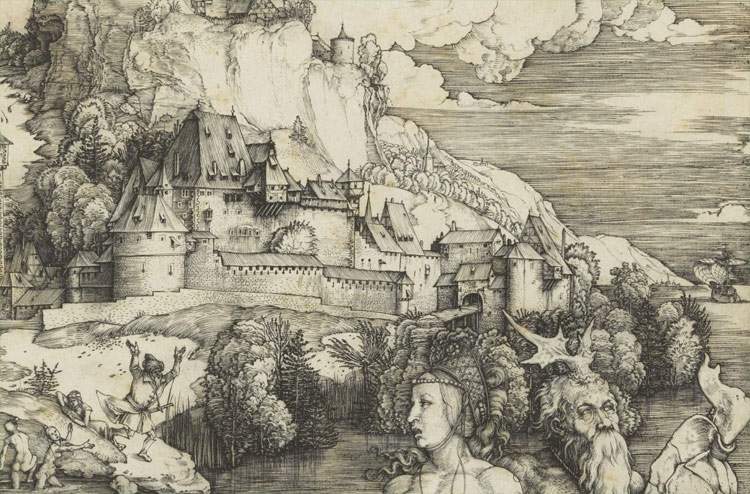Château de Chantilly hosts the largest exhibition on Dürer in France in 25 years
The Château de Chantilly in France will host a major exhibition on Albrecht Dürer (Nuremberg, 1471 - 1528) from June 4 to October 2, 2022, entitled Albrecht Dürer. Renaissance et Gravure. Regarded already in his lifetime as a universal genius, Albrecht Dürer continues to fascinate even today: with his engravings he helped shape the European Renaissance by placing himself at the center of the artistic exchanges of his time and beyond. Dürer is very rarely exhibited in France: the last French exhibition devoted to Dürer was more than a quarter of a century ago. Therefore, the Chantilly exhibition next summer, curated by Mathieu Deldicque and Caroline Vrande, will be an interesting opportunity to deepen our knowledge of the German artist.
For the first time, two major collections of works by Albrecht Dürer in France, that of the Musée Condé in Chantilly and that of the Bibliothèque nationale de France, are joining forces. More than 200 sheets will be brought together to compose an unprecedented journey through Dürer’s works that will aim to highlight the artist’s dazzling graphic creation, placed at the center of his own artistic practice and the upheavals of his time.
A native of the prolific artistic center of Nuremberg, Albrecht Dürer was a child of a vibrant Europe. His beginnings with Michael Wolgemut, his study trips in the footsteps of Martin Schongauer, his encounters with princes, clerics and humanists, his numerous sojourns in Italy and the Netherlands: each stage of his career is an opportunity to discover and assimilate the production of his peers, to integrate and surpass technical and formal innovations, and above all to influence and leave a lasting mark on his time. The exhibition will examine the education of one of the greatest artists of all time, his training, his early acquaintance with 15th-century Italian engraving, and the dialogue he established with the great Germanic engravers and draughtsmen of his time, particularly Martin Schongauer.
The famous woodcut cycles that made him famous (theApocalypse, the Life of the Virgin, and the Great Passion) will be displayed in their entirety, and will form the cornerstones of the exhibition itinerary. The discovery of Venice, during perhaps his first trip and his well-attested second journey, marked a turning point in his art. Drawings and engravings testify to the flourishing exchanges that took place between Dürer and the Venetian school during or after his travels. Exceptional drawings, sketches for his greatest masterpieces such as the Rosary Feast or the Landauer Altarpiece, give us insight into his maturation and artistic scope. Like many artists before him, Albrecht Dürer cultivated a comprehensive and humanist artistic project to understand and emulate nature. The study of the human body, anatomy, representation of the living and space was a constant throughout his career, as the exhibition shows. Dürer met the greatest artists of his time, such as Andrea Mantegna, Raphael Sanzio, and Leonardo da Vinci, and in return generated admiration among his peers. Marcantonio Raimondi and Raphael, as well as the Flemish artist Lucas de Leyde and the Germanic artists, some of whom worked in his studio, Hans Baldung Grien, Hans Wechtlin, Lucas Cranach and Hans Burgkmair will be featured in the exhibition to understand how Dürer created a true revolution.
In 1520-1521, at the height of his fame, and in order to secure an imperial pension, Dürer undertook a major trip to the Netherlands, which led to the creation of a rare notebook, the exceptional pages of which have been in the Condé Museum in storage for the past 20 years. The exhibition closes with this journey, all the ambitions and obsessions of an artist who definitively placed himself at the center of the Renaissance.
Dürer was a painter, draughtsman and engraver, but prints played a dominant role in his artistic practice. He was one of the first artists to elevate printmaking to the same level as the other arts. He mastered all the known techniques of his time: wood engraving, line engraving, etching and drypoint. A true genius of engraving, the quality of many of his sheets remains unmatched to this day. An almost complete panorama of his etched work will be on display. His major series on wood, revolutionary for its time, will be presented in its entirety. His universal masterpieces(Melencolia; The Knight, Death and the Devil; St. Jerome in His Cell) will be exhibited alongside more intimate compositions. Most importantly, Dürer’s works will be compared with the major creations of contemporary German, Italian and Flemish engravers who influenced his art or were inspired by it. The exhibition will highlight the intense rivalry between Dürer and the artists of his time, a phenomenon that contributed substantially to the flourishing of the Renaissance. With an exceptional grouping of more than 200 prints and drawings, the Chantilly exhibition will finally allow us to consider in a new light the central role played by the immense artist Albrecht Dürer.
All information can be found on the Château de Chantilly website.
 |
| Château de Chantilly hosts the largest exhibition on Dürer in France in 25 years |
Warning: the translation into English of the original Italian article was created using automatic tools. We undertake to review all articles, but we do not guarantee the total absence of inaccuracies in the translation due to the program. You can find the original by clicking on the ITA button. If you find any mistake,please contact us.




























